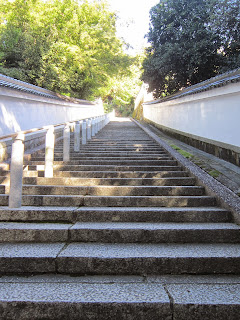Visiting the doctor is never a pleasant experience, even one you know well and have been seeing for 10 or 20 years. Going to a doctor in a foreign country is even more disagreeable. Depending on your fluency in the native tongue, it can be not only frustrating but scary.
I have a bad back. From time to time it bothers me. In 2009, on the recommendation of my dear friend Simone I began seeing an acupuncturist (Marc Passman) in New York City to treat the pain. It worked, and I've avoided Western doctors for this kind of thing ever since.
A few weeks ago when I was experiencing back pain here in Kyoto, I thought, let me find an acupuncturist. This is Japan; acupuncture is not "alternative" or "Eastern" medicine here, it's just what they do. I found one with the help of Mineko.
I went to a local clinic here in Uji-City. I was a little nervous. Not because I don't know what acupuncture entails, but because I knew I really couldn't communicate what exactly was wrong, why I had come to see them. Mineko had given them a brief history of my back problems and explained the pain I was currently having, but this was second-hand information delivered by telephone from another continent. They were going to have questions for me. Of course.
In the West, acupuncture is a close cousin to a health spa. That is, it is extremely pleasant, calming, quiet, relaxing. It is nothing like a doctor's office. There is a great deal of thought that goes into the design and decoration. Unlike a traditional doctor's office it is a place you enjoy visiting. There is Asian art, and books on healing; there is soft (albeit sometimes clichéd New Age) music playing, maybe incense burning; the lighting is warm and low.
The acupuncture clinic in Uji-City was nothing like that. It was something like walking into a physical therapy center, more casual than a proper doctor's office, but more clinical than my description above. There is little or no privacy; it is pretty much a communal experience. All the conversations of the other doctors and patients are there for everyone to hear (if they understand Japanese, of course).
The treatment was also very different. More painful. The doctor would flick the needles in, work them around a bit, then remove them, never really letting them rest. I don't like needles, ironically, so I never watch. But this felt like each needle hit a nerve, like the needles were the length and width of porcupine quills and he was pushing them as deep as they would go. Oh man, it was unpleasant.
He loaded me up with needles, removed them, then loaded me up again. Then he did something I later learned is called moxibustion, in which burning cones of yomogi (mugwort) are placed on the skin at the acupuncture points. It is meant to stimulate blood circulation. They smell like incense and warm up like crazy. This was followed by some acupressure, pressing and pushing different points. I was there for more than an hour.
Unlike my treatments in New York and Los Angeles I couldn't wait for it to end. The doctor was very friendly, concerned, helpful, but I have to say this was the most aggressive and harsh acupuncture I've ever encountered. I was actually sore when I left, like I'd been to the gym or something.
So I consulted Simone again. She said that what I experienced was a very traditional Chinese style acupuncture, and that I should find someone that practices Toyohari. This is a more delicate form of acupuncture with an emphasis on pulse diagnosis. Apparently it was developed by blind acupuncturists in Japan after the War. I enlisted Mineko's help again.
I am happy to report that Toyohari is amazing. What a difference. It was totally relaxing and revitalizing. The environment at the new place called Matsuda-kanpou is still very clinical, but the overall experience is a hundred times more pleasant than the brutish thing I underwent two weeks ago. I have even scheduled another appointment.
So concludes your lesson in traditional East Asian medicine. Arigato gozaimas.













































